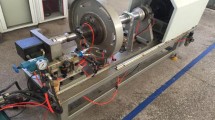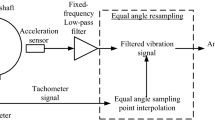Abstract
The time synchronous averaging (TSA) is a well-known technique used for early detection of bearing failure in electrical machines. This method is very efficient if the characteristic default frequency is perfectly known. In this article, a reduced frequency model, derived from ESPRIT algorithm, is used to provide a very accurate estimation of the fault frequency. The precision obtained on this frequency allows to apply TSA algorithm under optimal conditions. The proposed method is tested on simulated and real vibration signals for inner and outer ring faults. Finally, a fault indicator is proposed to discriminate the healthy case from the faulty one.














Similar content being viewed by others
References
Report of large motor reliability survey of industrial and commercial installations, part I. IEEE Trans Ind Appl IA-21(4):853–864 (1985)
Jin X, Zhao M, Chow TWS, Pecht M (2014) Motor bearing fault diagnosis using trace ratio linear discriminant analysis. IEEE Trans Ind Electron 61(5):2441–2451
Prieto MD, Cirrincione G, Espinosa AG, Ortega JA, Henao H (2013) Bearing fault detection by a novel condition-monitoring scheme based on statistical-time features and neural networks. IEEE Trans Ind Electron 60(8):3398–3407
Harmouche J, Delpha C, Diallo D (2014) Incipient fault detection and diagnosis based on Kullback–Leibler divergence using principal component analysis: part I. Signal Process 94:278–287
Picot A, Obeid Z, R\(\acute{\rm {e}}\)gnier J, Poignant S, Darnis O, Maussion P (2014) Statistic-based spectral indicator for bearing fault detection in permanent-magnet synchronous machines using the stator current. Mech Syst Signal Process 46(2):424–441
Harmouche J, Delpha C, Diallo D (2015) Incipient fault detection and diagnosis based on Kullback–Leibler divergence using principal component analysis: part II. Signal Process 109:334–344
Li M, Yang J, Wang X (2015) Fault feature extraction of rolling bearing based on an improved cyclical spectrum density method. Chin J Mech Eng 28(6):1–8
Kunli M, Yunxin W (2011) Fault diagnosis of rolling element bearing based on vibration frequency analysis. Third international conference on measuring technology and mechatronics automation (ICMTMA), vol 2, pp 198–201
Zhang X, Kang J, Bechhoefer E, Teng H (2014) Enhanced bearing fault detection and degradation analysis based on narrowband interference cancellation. Int J Syst Assur Eng Manag 5(4):645–650
Hecke B, Qu Y, He D, Bechhoefer E (2014) A new spectral average-based bearing fault diagnostic approach. J Fail Anal Prev 14(3):354–362
El Bouchikhi EH, Choqueuse V, Benbouzid MEH (2015) Induction machine faults detection using stator current parametric spectral estimation. Mech Syst Signal Process 52:447–464
Labar H, Zerzouri N, Kelaiaia M (2015) Wind turbine gearbox fault diagnosis based on symmetrical components and frequency domain. Electr Eng 97(4):327–336
Bendjama H, Bouhouche S, Boucherit MS (2012) Application of wavelet transform for fault diagnosis in rotating machinery. Int J Mach Learn Comput 2(1):82–87
Yan R, Gao RX, Chen X (2014) Wavelets for fault diagnosis of rotary machines: a review with applications. Signal Process 96:1–15
Georgoulas G, Loutas T, Stylios CD, Kostopoulos V (2013) Bearing fault detection based on hybrid ensemble detector and empirical mode decomposition. Mech Syst Signal Process 41(1):510–525
Muhammad I, Nordin S, Rosdiazli I, Vijanth SA, Hung NT, Magzoub MA (2015) Analysis of bearing surface roughness defects in induction motors. J Fail Anal Prev 15(5):730–736
McFadden PD, Toozhy MM (2000) Application of synchronous averaging to vibration monitoring of rolling element bearings. Mech Syst Signal Process 14(6):891–906
McFadden PD (1984) Model for the vibration produced by a single point defect in a rolling element bearing. J Sound Vib 96(1):69–82
Zhan Y, Makis V (2006) A robust diagnostic model for gearboxes subject to vibration monitoring. J Sound Vib 290(3):928–955
Akbar MA, Tila HB, Khalid MZ, Ajaz MA (2009) Bit error rate improvement using ESPRIT based beamforming and RAKE receiver. IEEE 13th international multitopic conference (INMIC), pp 1–6
Dhope TS, Simunic D (2013) On the performance of DoA estimation algorithms in cognitive radio networks: a new approach in spectrum sensing. 36th International convention on information & communication technology electronics & microelectronics (MIPRO), pp 507–512
Gökta T, Arkan M, Özgüven ÖF (2015) Detection of rotor fault in three-phase induction motor in case of low-frequency load oscillation. Electr Eng 97(4):337–345
Schoen RR, Habetler TG, Kamran F, Bartfield RG (1995) Motor bearing damage detection using stator current monitoring. Trans Ind Appl 31(6):1274–1279
Lindh T, Ahola J, Kamarainen JK, Kyrki V, Partanen J (2003) Bearing damage detection based on statistical discrimination of stator current. IEEE symposium on diagnostics for electric machines, power electronics and drives, pp 177–181
Immovilli F, Bellini A, Rubini R, Tassoni C (2010) Diagnosis of bearing faults in induction machines by vibration or current signals: a critical comparison. IEEE Trans Ind Appl 46(4):1350–1359
Case Western Reserve University Bearing Data Center Website. http://csegroups.case.edu/bearingdatacenter/home
Marple SL (2003) Computing the discrete-time analytic signal via FFT. IEEE Trans Signal Process 47(9):177–181
Roy RH, Kailath T (1989) ESPRIT—estimation of signal parameters via rotational invariance techniques. IEEE Trans Acoust Speech Signal Process 37(7):984–995
Badeau R, Bertrand D, Richard G (2006) A new perturbation analysis for signal enumeration in rotational invariance techniques. IEEE Trans Signal Process 54(2):450–458
Acknowledgments
This work has been realized through the collaboration between LaSIE laboratory, University of La Rochelle, France and LIAS laboratory, University of Poitiers, France, with the financial support of FEDER program no: 33288-2010.
Author information
Authors and Affiliations
Corresponding author
Rights and permissions
About this article
Cite this article
Masmoudi, M.L., Etien, E., Moreau, S. et al. Single point bearing fault diagnosis using simplified frequency model. Electr Eng 99, 455–465 (2017). https://doi.org/10.1007/s00202-016-0441-y
Received:
Accepted:
Published:
Issue Date:
DOI: https://doi.org/10.1007/s00202-016-0441-y




